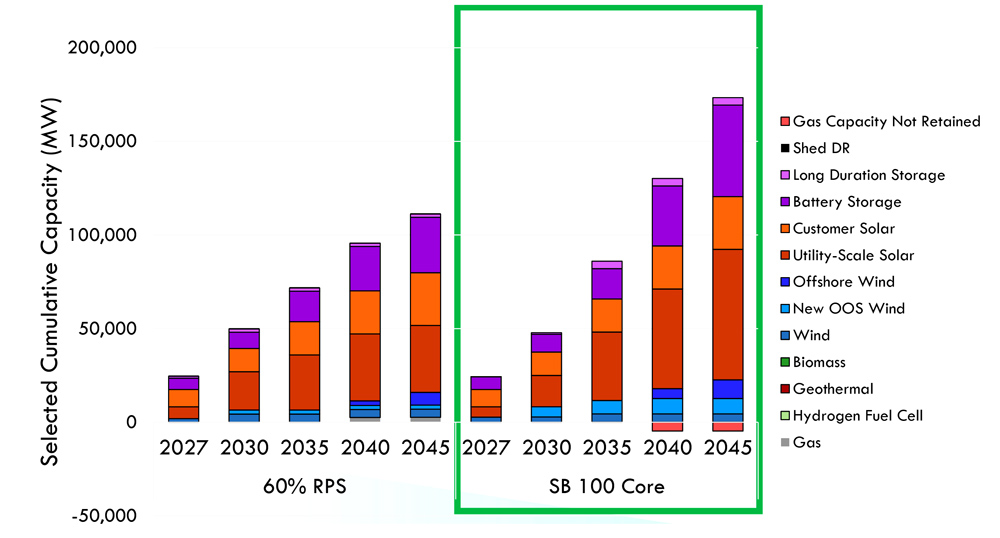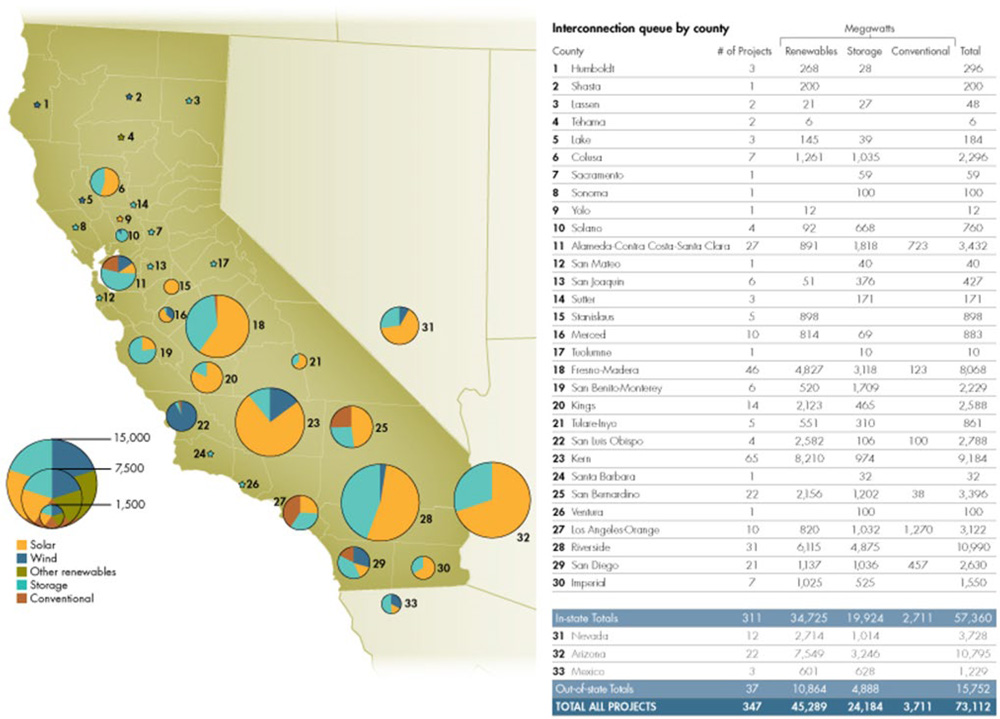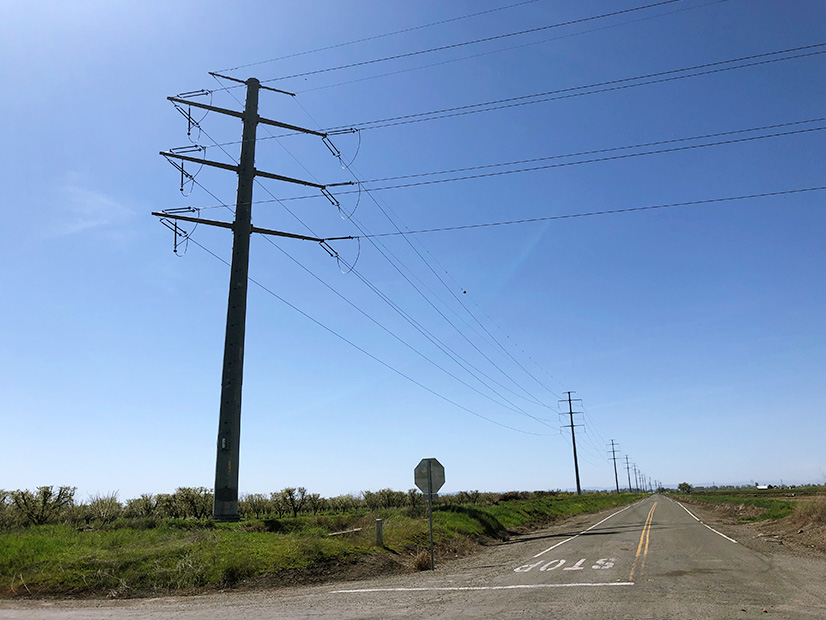Speakers at a California Energy Commission (CEC) workshop Wednesday addressed some of the more difficult problems in the state’s transition to 100% clean energy, including the need for new transmission and efforts to keep and decarbonize natural gas.
The daylong workshop — part of a joint planning process by the CEC, the California Public Utilities Commission (CPUC) and the California Air Resources Board (CARB) — dealt with the huge influx of resources needed to comply with Senate Bill 100, the landmark 2018 law that requires utilities to serve retail customers with 100% clean energy by 2045.
Achieving that objective will require an infrastructure buildout of unprecedented proportions and greater cooperation by the CEC, CAISO and the CPUC, the three entities responsible for energy planning and procurement in California, speakers said.

CEC Adviser Liz Gill said her commission’s “high-electrification” planning scenario, which anticipates widespread adoption of electric vehicles and heating-and-cooling appliances, shows the state must add 172 GW of new resources to the approximately 80 GW it had as of 2019. (See Study: Calif. Must Build Renewables at Record Rate.)
“We’re really looking at tripling our electric grid capacity,” Gill said. The SB 100 Joint Agency Report released in March envisions massive increases in utility-scale solar, rooftop solar, battery storage, and onshore and offshore wind, she said.
New Transmission
More transmission is needed to deliver energy from the threefold increase in generating and storage resources to urban load centers, speakers said.
Neil Millar, CAISO vice president of transmission planning and infrastructure development, said the pace of development “needs to be considerably accelerated, and that applies not only to the resources but to the transmission development that will underpin those resources.”
Developing resources with longer lead times, such as offshore wind, and new transmission lines to serve those resources will require years of planning, “so it’s critical that we get going as soon as possible,” Millar said.
Jeff Billinton, CAISO’s director of transmission infrastructure planning, said the push to add generating and storage resources has led to interconnection queue requests that “exceed all previous levels and expectations.”
Over the past decade, CAISO received an average of 113 queue requests per year, he said. In April, the ISO received 363 interconnection requests totaling 106 GW, Billinton said.
“This volume is creating staffing resource challenges for the ISO and, in particular, for the participating transmission owners,” he said.
Some speakers urged better coordination and planning to avoid future problems.
James Avery, an energy consultant who serves on the WECC Board of Directors, said the state needs to avoid the “planning paralysis that has plagued us for decades and … move as expeditiously as possible to evaluate all of the possible transmission projects that are before the ISO in the current [transmission planning process] cycle.”
Avery made his comments on behalf of Western Grid Group, which “seeks to accelerate the incorporation of a broad range of cost-effective, low-carbon technologies into the electric system,” according to its website.
“In order for California to meet our SB 100 goals, the state must develop a roadmap,” Avery said. “There’s been a lot of talk this morning about different initiatives, different objectives, but no one has put this all together into a roadmap that clearly lays out what we have to do to meet the 2045 time period.”
“Simply connecting renewable resources to the ISO grid will not enable us to reduce our dependence on the natural gas that’s used to serve our urban load centers,” he said. “If we do not build the transmission to deliver renewable resources to our coastal regions, we will never be able to meet our SB 100 goals.”

Most utility-scale renewable resources — solar, geothermal, wind and hydropower — are far from the state’s coastal cities, requiring new transmission connections.
“We all know it takes 10 years to build any new transmission facility,” Avery said.
“Without the roadmap, we will still be talking about what needs to be done when it’s too late to do anything,” he said.
Sticking with Gas
Another difficult issue is what to do with natural gas, a major fuel source for the state’s generators and consumers.
After last year’s rolling blackouts, there has been a growing call to retain aging natural gas plants until viable clean-energy substitutes can come online to provide reliability.
In her presentation, the CEC’s Gill said, “retaining some natural gas power capacity may minimize costs while ensuring an uninterrupted power supply during the transition to 100% clean energy.”
On May 21, the CPUC proposed that utilities procure an additional 1,000 MW to 1,500 MW of fossil fuel generation to avoid capacity shortfalls, which broke with nearly all state policy in recent years. (See CPUC Proposes Adding 11.5 GW of New Resources.)
“A failure to provide insurance to keep grid reliability is a far greater threat to public confidence and public health than running state-of-the-art fossil-fueled generators a few extra hours a year,” the proposed decision said.
Utilities that rely on natural gas generation and sell gas directly to consumers said the fuel could be partly decarbonized using carbon-capture technologies or by mixing it with green hydrogen, produced with excess solar power.
Jan Berman, director of energy strategy and innovation with Pacific Gas and Electric, said gas remains essential for grid reliability because it powers plants that meet peak demand.
“Like many here, we anticipate that decarbonized gas-fueled generation resources will be required in the long run to ensure peaking capability for California,” Berman said. “As California’s current fossil generation fleet begins to retire, these plants will be replaced by new generation that uses decarbonized gaseous fuels. This may be some combination of generation fueled by hydrogen, renewable natural gas … and possibly fossil [fuels] combined with carbon capture and storage.”
“We think it’s important to maintain flexibility for the pathways that will emerge as these technologies advance, and it’s really important for all of us to participate in ongoing research on the future of carbon-free gas generating resources,” she said.
Jeff DeTuri, policy and strategy manager at San Diego Gas & Electric, said the utility supports the goals of SB 100 but also remains concerned about resource adequacy.
“Natural gas is a critical partner to provide reliability to support renewable energy in California,” DeTuri said. “It needs to be supported by the joint agencies.”
The definition of a zero-carbon resource “should include combustion of renewable natural gas and green hydrogen and combustion of natural gas with carbon-capture sequestration,” he said. “SDG&E believes that these research types are essential to provide reliability.”


